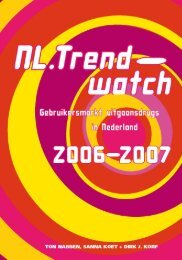You also want an ePaper? Increase the reach of your titles
YUMPU automatically turns print PDFs into web optimized ePapers that Google loves.
pills tested in buses proved to be somewhat below average in strength, that could<br />
have been characteristic of the regional market, since the existing testing offices in<br />
the selected regions where the bus operated also reported lower pill strengths than<br />
regions elsewhere. In comparison with the existing offices, ecstasy users visiting the<br />
bus were less willing to surrender their pills for further analysis if these could not be<br />
identified on the spot. That could be because many of them wanted to take the pill<br />
the same evening. Although some of the non-surrendered (but recorded) pills later<br />
turned out to be known types, the reluctance of users to part with their pills means<br />
that any new market segments potentially reached by the bus may remain hidden to<br />
DIMS after all.<br />
Ecstasy users<br />
Most of the ecstasy users in the bus subsample who came in for testing had never<br />
had their pills tested before at an existing office. This indicates that testing in nightlife<br />
areas indeed succeeded in reaching previously uncontacted ecstasy users. To some<br />
extent the method also attracted different segments of the users’ population in terms<br />
of background characteristics, patterns of ecstasy use, and consumption patterns of<br />
other legal and illicit substances. Ecstasy users that had their pills tested on the bus<br />
were younger and some of them expressed different music preferences. They had<br />
started doing ecstasy relatively early, and their current use of ecstasy, and of stimulants<br />
in general, was higher than that of the group that tested in the existing offices.<br />
They usually bought their own ecstasy, and they were relatively more likely to buy it<br />
from a dealer they knew than from a friend. They were also relatively more likely than<br />
those testing in offices to buy it on a night out, although the majority of respondents<br />
in both subsamples still usually bought it prior to going out. In sum, the bus clients<br />
were younger, more active ecstasy users who probably also took slightly more risks<br />
in purchasing the drug.<br />
Viability<br />
The practical viability of bus testing was likewise heavily dependent on the policy priorities<br />
of addiction care agencies and local authorities in the region. Some regions<br />
already show some reluctance towards the existing testing method, and these would<br />
seem least likely to support on-site testing in nightlife areas. The practical implementation<br />
of bus testing presented no real problems in the regions studied. Although test-<br />
ing in a bus in a nightlife area is more costly than the services now existing, it would<br />
not necessarily cost more than office-plus testing, provided a bus is already available<br />
and no additional bus driver has to be engaged.<br />
Emergencies<br />
In view of its direct contact with the nightlife area, bus testing would enhance the potential<br />
for launching targeted warning campaigns.<br />
89












